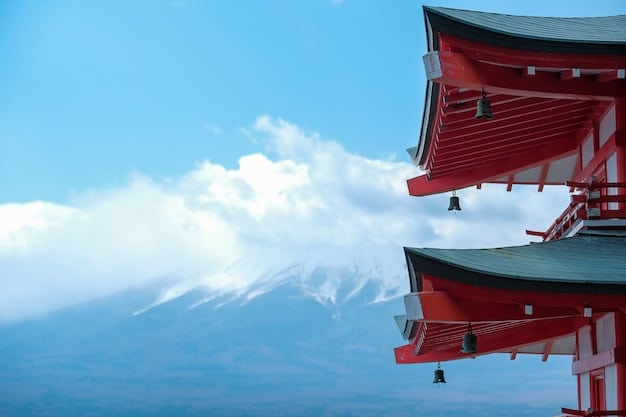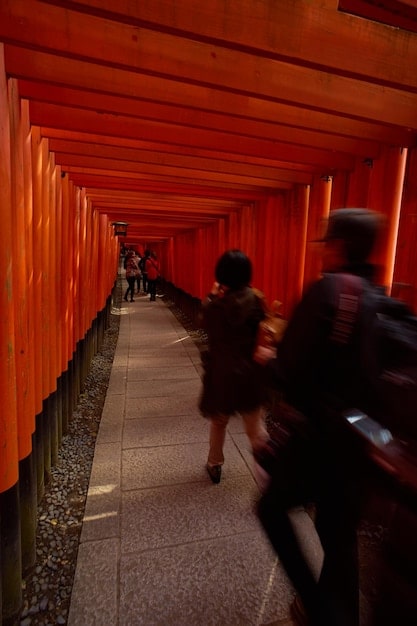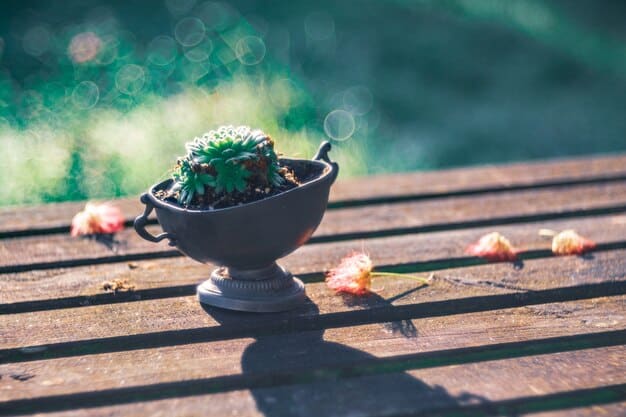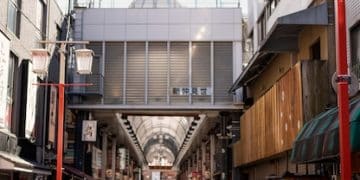Japanese Shrine and Temple Etiquette: A 2025 Guide for US Visitors

Navigating Japanese shrine and temple etiquette in 2025 requires understanding purification rituals, proper behavior during prayers, and respecting sacred spaces, ensuring a meaningful and respectful experience for US visitors.
Planning a trip to Japan in 2025? Immersing yourself in the serene beauty of Japanese shrines and temples is a must, but understanding the proper etiquette is crucial for a respectful and enriching experience. This guide will equip you with the知識 needed to confidently navigate these sacred spaces.
Understanding the Significance of Shrines and Temples
Before diving into the etiquette, it’s helpful to understand the fundamental differences between Shinto shrines and Buddhist temples. This knowledge will enhance your appreciation and guide your behavior in these sacred locations.
Knowing the difference helps you appreciate the cultural context. Navigating Japanese shrine and temple etiquette becomes more meaningful when you understand the spiritual foundations of these places.
Shinto Shrines: The Abodes of the Kami
Shinto shrines, marked by distinctive torii gates, are dedicated to the Kami, spirits that inhabit all things. These spaces are deeply connected to Japanese mythology and daily life.
Buddhist Temples: Centers of Enlightenment
Buddhist temples, often adorned with intricate statues and serene gardens, originated in India and arrived in Japan via China and Korea. They serve as centers for Buddhist practice and reflection.

- Symbolic Gateways: Torii gates symbolize the transition from the mundane world to the sacred realm of the Kami.
- Purification Fountains: Temizuya fountains offer a place to cleanse your hands and mouth before approaching the main hall.
- Ema Votive Tablets: Ema are wooden plaques where visitors write their wishes and prayers.
- Omikuji Fortunes: Omikuji are paper fortunes that can be purchased, offering guidance and insight.
Understanding the unique purposes of these sacred spaces allows you to navigate them with respect and appreciation.
Essential Etiquette at Shinto Shrines
Shinto shrines are places of profound reverence. Observing proper etiquette shows respect for the Kami and the sacred environment. These practices are steeped in tradition and have been passed down through generations.
By practicing appropriate etiquette at Shinto shrines, visitors contribute to the preservation of these timeless traditions and cultivate cultural sensitivity.
Approaching the Shrine
As you approach a Shinto shrine, pause before the torii gate. A respectful bow acknowledges the sacredness of the space.
This simple gesture sets the tone for your visit, signaling an understanding of the shrine’s significance.
Purification Ritual at the Temizuya
The temizuya, or water basin, offers a ritual purification. Use the provided ladle to cleanse your hands and mouth, symbolizing a cleansing of the body and spirit.
- Rinse the Left Hand: First, rinse your left hand.
- Rinse the Right Hand: Then, rinse your right hand.
- Rinse the Mouth: Cup water in your left hand and rinse your mouth, discreetly spitting the water into the drain—never back into the basin.
- Clean the Ladle: Finally, rinse the ladle so the next person can use it.
Purification rituals are a fundamental aspect of Shinto etiquette, preparing visitors to respectfully engage with the shrine.

Navigating Buddhist Temple Customs
Buddhist temples, with their serene atmosphere, offer a different kind of spiritual experience. Understanding the customs and practices is important for demonstrating respect.
These guidelines can help visitors gracefully participate in temple rituals and deepen their experience.
Entering the Temple Grounds
Upon entering a Buddhist temple, pay attention to any signs or instructions provided. Remove your hat or sunglasses as you enter the main hall.
The Incense Offering
Many temples have an incense burner near the entrance. Purchase incense sticks, light them, and place them in the burner, wafting the smoke towards you for purification.
Offering incense is a gesture of respect and a way to purify both the body and mind.
Common Dos and Don’ts
Beyond the specific practices at shrines and temples, some general guidelines will help you navigate these sacred spaces respectfully. Being mindful of these points will greatly enhance your experience.
These dos and don’ts are essential for showing respect and creating a harmonious atmosphere.
Appropriate Attire
Dress modestly when visiting shrines and temples. Avoid revealing clothing and opt for attire that shows respect for the sacred setting.
Maintaining Silence
Keep your voice low and avoid loud conversations. Shrines and temples are places of peace and introspection.
- No Photography in Restricted Areas: Be mindful of photography restrictions, and never take photos during religious ceremonies.
- Respect Prayer Times: If a service or ceremony is in progress, observe quietly from a respectful distance.
- Avoid Pointing: Refrain from pointing at sacred objects or individuals.
Respecting the local customs and traditions contributes significantly to a harmonious cultural exchange and a richer travel experience.
Making Offerings and Prayers
Participating in offerings and prayers can be a meaningful way to engage with the spiritual essence of shrines and temples. These actions, when performed respectfully, can deepen your connection to the site.
Participating in these rituals can promote a deeper understanding of Japanese spirituality.
The Offering Box
Most shrines and temples have an offering box where visitors can donate money. A small offering is a sign of respect and support.
Clapping and Bowing
At Shinto shrines, it is customary to clap twice before bowing deeply to show respect to the Kami.
Beyond the Basics: Deepening Your Experience
To further enhance your visits to Japanese shrines and temples, consider delving deeper into their history, art, and cultural significance. This will give you a more profound appreciation for these sacred spaces.
Understanding the historical and cultural context enriches one’s visit immensely.
Research and Preparation
Take the time to research the specific shrines and temples you plan to visit. Understanding their history and purpose will deepen your experience.
Engage with Local Guides
Consider hiring a local guide who can provide valuable insights into the significance of the sites and the nuances of Japanese culture.
- Attend Festivals: If possible, plan your visit to coincide with local festivals, which offer a vibrant glimpse into Japanese traditions.
- Take a Calligraphy or Meditation Class: Many temples offer calligraphy or meditation classes, providing a hands-on experience of spiritual practice.
- Learn Basic Japanese Phrases: Knowing a few basic Japanese phrases can enhance your interactions and demonstrate respect.
By taking these steps, you can elevate your experience from being a mere tourist to becoming a respectful and informed traveler.
| Key Point | Brief Description |
|---|---|
| ⛩️ Shrine vs. Temple | Shrines are Shinto, marked by torii; temples are Buddhist, with statues. |
| 💧 Purification | Use temizuya to cleanse hands and mouth before entering. |
| 🙏 Prayer Etiquette | Offer money, bow, and clap (shrines) or pray silently (temples). |
| 🤫 Respectful Behavior | Dress modestly, keep voices low, and respect ceremonies. |
FAQ About Japanese Shrines and Temples
▼
It’s best to dress modestly. Avoid overly revealing clothing and opt for respectful attire. Clean and neat clothing is always appreciated.
▼
Photography is generally allowed, but be mindful of signs prohibiting it in certain areas. Never take photos during religious ceremonies or services to show respect.
▼
There is no set amount. A small offering, even a few coins, is a gesture of respect. The amount isn’t as important as the sincerity of your gesture.
▼
Omikuji are paper fortunes that offer guidance or predictions. If you receive a bad fortune, it’s customary to tie it to a designated tree or rack to leave the bad luck behind.
▼
Yes, shrines and temples in Japan are generally open to people of all faiths. Everyone is welcome to visit and experience these sacred spaces with respect and reverence.
Conclusion
By understanding and adhering to the etiquette of Japanese shrines and temples, US visitors can cultivate deeper cultural sensitivity and contribute to the preservation of timeless traditions, profoundly enriching their travel experience.





